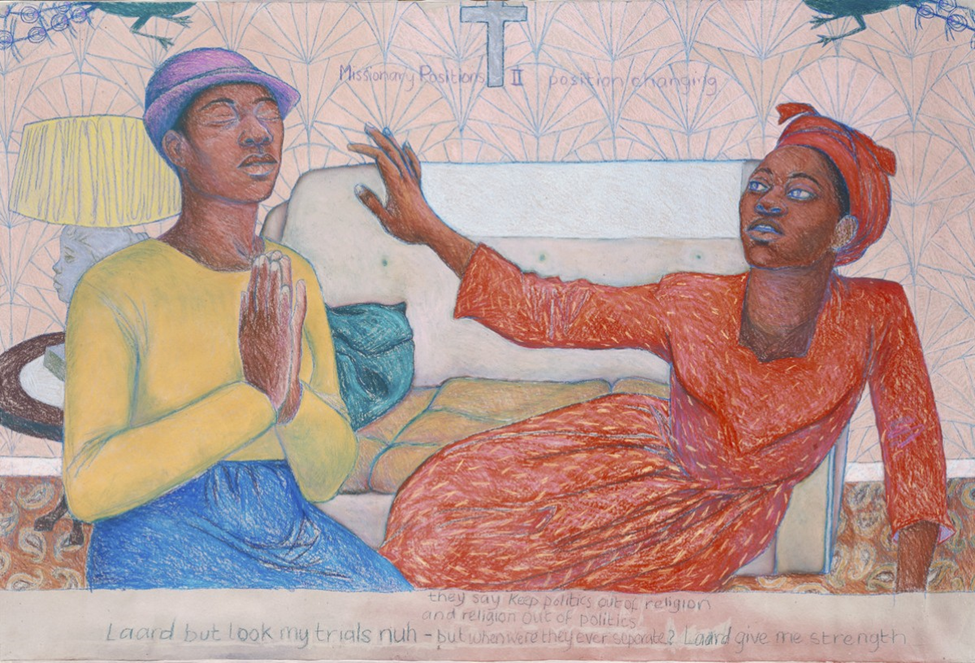Missionary Position II
My visit at AGO Exhibition Center was great as I had an opportunity of seeing Missionary Position II by Sonia Boyce (1985). Upon keen observation of this art, I noted that it resembles the artist. From this, I presumed that the story is around a young person's response to authority. The title primarily illustrates how colonialism affected culture, particularly the horrible part played by British missionaries in the colonization of Africa and the Caribbean. Two vibrantly dressed women are seen in the picture in what looks to be a living room. With their head up and eyes closed, as if in prayer, one person sits on the floor (Life between islands: Caribbean-British art 1950s-now). With a slight lean, the other woman extends her hand to touch the first. The walls are covered in patterned wallpaper, with a blue crucifix positioned between the women, beautiful birds framing each upper corner, and an orange paisley carpet extending the artist's bold use of color.
The drawing's emphasis on juxtaposing three-dimensionality and flatness is its most remarkable aspect. The background wallpaper draws attention to the lack of declining viewpoint. The interior of the piece has significance since Boyce's life revolves around the background objects. We can see a sofa and the lampstand with the bust of a black girl's head on it. This suggests a private and home setting that is unique to Boyce and is ingrained in her cultural memory (Life between islands: Caribbean-British art 1950s-now). Similarly, we can see the Paisley carpet, named for a Scottish town, originated in Asia and represents the contextual impacts of cultural appropriation and imperialism. In addition to serving as ornamental elements and representing her early years, their placement suggests a conflict between the two figures below.
Additionally, the art depicts two aspects of black femininity, the accepting side and the denying side and the conflict between them as they attempt to coexist. The two characters, one with closed eyes and the other with an ear that has been slightly warped in the drawing process, are not communicating with one other (Life between islands: Caribbean-British art 1950s-now). Boyce subtly suggests that there isn't much talk about religion among this group of people. The art suggests that the woman on the left has fully yielded, while the woman on the right is defying authority. Boyce actually dominates the room as her own story, using herself as a model for both personas. The predominantly home pastel background makes the red-clad woman stand out as though she is in opposition to her surroundings. Her African attire symbolizes holding onto the diaspora, and the head wrap, which is important in native black culture and a symbol of resistance against imposed Christianity, has ties to Pan-Africanism and Rastafarianism. These traditions play a crucial role in resisting against structures rooted in slavery, imperialism, and capitalism and also maintaining “ontology (cultural traditions, beliefs, values)” (Week 3, Slide 12). The artwork demonstrates that through culture, social, political, economic, and cultural norms originating in anticolonial and antislavery efforts can be disrupted.
Appendix

Sonia Boyce, Missionary Position II, 1985. Watercolour, pastel and crayon on paper, Support: 123.8 × 183 cm. Tate. Purchased 1987. T05020. © Sonia Boyce (Copyright Visual Arts-CARCC, 2023) Photo: Tate. (https://ago.ca/exhibitions/life-between-islands)
Work Cited
“Life between Islands: Caribbean-British Art 1950s-Now.” Art Gallery of Ontario, ago.ca/exhibitions/life-between-islands. Accessed 27 Jan. 2024. Week 3: Culture and Context: Race, Institutions, and Exclusion (Slide 1-25)